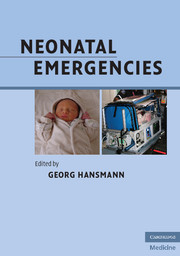Book contents
- Frontmatter
- Contents
- List of contributors
- Foreword (1)
- Foreword (2)
- Preface
- Acknowledgments
- Section 1 Organization of neonatal transport
- Section 2 Basics in cardiopulmonary resuscitation of newborn infants
- Basic equipment setup for initial neonatal care and resuscitation
- Drugs for neonatal emergencies
- Postnatal cardiopulmonary adaptation
- ABC Techniques and Procedures
- Sunctioning
- Stimulation, oxygen supplementation, bag-and-mask ventilation (M-PPV), pharyngeal/bi-nasal CPAP, and pharyngeal positive pressure ventilation
- Endotracheal intubation and gastric tube placement
- Laryngeal mask airway (LMA)
- Chest compressions
- Peripheral venous access
- Umbilical vein/artery catheterization (UVC, UAC)
- Central venous access (internal jugular vein)
- Intraosseous access
- Cord clamping
- Management of high-risk infants in the delivery room
- Monitoring in the delivery room and during neonatal transport
- Hygiene in the delivery room and during neonatal transport (infection control)
- When to call a pediatrician to the delivery room
- Checklist for the postnatal treatment of newborn infants
- Assigning individual duties in the delivery room
- Clinical assessment of the newborn infant
- Cardiopulmonary resuscitation of newborn infants at birth
- Volume therapy and sodium bicarbonate supplementation in preterm and term newborn infants
- Absolute and relative indications for neonatal transport and NICU admission
- Communication with mother and father
- Coordinating neonatal transport and patient sign-out to the NICU team
- Documentation and feedback after neonatal emergency transport
- Ethics in neonatal intensive care
- Perinatal images of preterm and term infants
- Mechanical ventilation of the neonate
- Questions for review (basics)
- References (Section 2)
- Section 3 Classic and rare scenarios in the neonatal period
- Section 4 Transport
- Section 5 Appendix
- Index
- Plate section
Clinical assessment of the newborn infant
from Section 2 - Basics in cardiopulmonary resuscitation of newborn infants
Published online by Cambridge University Press: 05 March 2012
- Frontmatter
- Contents
- List of contributors
- Foreword (1)
- Foreword (2)
- Preface
- Acknowledgments
- Section 1 Organization of neonatal transport
- Section 2 Basics in cardiopulmonary resuscitation of newborn infants
- Basic equipment setup for initial neonatal care and resuscitation
- Drugs for neonatal emergencies
- Postnatal cardiopulmonary adaptation
- ABC Techniques and Procedures
- Sunctioning
- Stimulation, oxygen supplementation, bag-and-mask ventilation (M-PPV), pharyngeal/bi-nasal CPAP, and pharyngeal positive pressure ventilation
- Endotracheal intubation and gastric tube placement
- Laryngeal mask airway (LMA)
- Chest compressions
- Peripheral venous access
- Umbilical vein/artery catheterization (UVC, UAC)
- Central venous access (internal jugular vein)
- Intraosseous access
- Cord clamping
- Management of high-risk infants in the delivery room
- Monitoring in the delivery room and during neonatal transport
- Hygiene in the delivery room and during neonatal transport (infection control)
- When to call a pediatrician to the delivery room
- Checklist for the postnatal treatment of newborn infants
- Assigning individual duties in the delivery room
- Clinical assessment of the newborn infant
- Cardiopulmonary resuscitation of newborn infants at birth
- Volume therapy and sodium bicarbonate supplementation in preterm and term newborn infants
- Absolute and relative indications for neonatal transport and NICU admission
- Communication with mother and father
- Coordinating neonatal transport and patient sign-out to the NICU team
- Documentation and feedback after neonatal emergency transport
- Ethics in neonatal intensive care
- Perinatal images of preterm and term infants
- Mechanical ventilation of the neonate
- Questions for review (basics)
- References (Section 2)
- Section 3 Classic and rare scenarios in the neonatal period
- Section 4 Transport
- Section 5 Appendix
- Index
- Plate section
Summary
! The evaluation of neonates is based on three signs: breathing, heart rate, and color
! Evaluation → Decision → Action
! The one who waits for the umbilical artery pH to come back misses the train!
Breathing
Immediately after the initial postnatal chest excursions, the neonate should be able to breathe spontaneously during the next few seconds, and gradually turn rosy (beginning at the torso, then the extremities) and should maintain a heart rate >100 bpm.
Gasping, apnea and bradycardia (HR <100 bpm) are indications for initiating bag-and-mask ventilation/PPV (see below). Prolonged and severe hypoxia results in anaerobic glycolysis, hypoglycemia, lactic acidosis, peripheral vasoconstriction/shock, cardiac depression and subsequently cell death (CNS, myocardium, and other organs/tissues).
Heart rate
The heart rate (HR) is determined by quick palpation of the pulse at the base of the umbilical cord and/or cardiac auscultation. A HR >100 bpm and variation with breathing are normal.
If the HR is below 100 bpm in spite of 30 s of respiratory stimulation, apply (repeat) oropharyngeal suctioning quickly, then initiate mask-PPV and continue resuscitation according to the standard algorithm (Figure 2.38, p. 157).
Skin color
A well-adapted neonate has rosy mucous membranes without oxygen supplementation. Acrocyanosis (bluish extremities, rosy body) is usually normal for a neonate, but it may be a sign of low environmental temperature (peripheral vasoconstriction).
Signs of central cyanosis are seen on the face, torso and mucous membranes. Extreme pallor can indicate reduced cardiac output, severe anemia (in which case one does not see cyanosis), infection, hypovolemia, acidosis, and/or hypothermia.
- Type
- Chapter
- Information
- Neonatal Emergencies , pp. 142 - 149Publisher: Cambridge University PressPrint publication year: 2009



